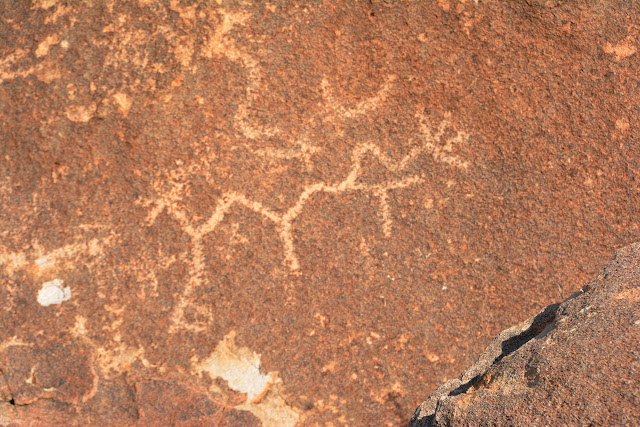We are going to those distant mountains.
Getting closer
Keyhole Canyon is straight ahead. It should be described as a "box" canyon because that is what it is. One way in, and one way out.
PLEASE EMBIGGEN THIS PHOTO!
I'm starting from the far end of the canyon, because that is where this AMAZING dry waterfall was. I had my wife get into the photo for scale. From bottom to top (that disappears into the sunlight) it was easily 10 stories tall. The front of the canyon is 20-30 yards wide, but it narrows quickly, and we had to squeeze into the last part. All of the white stone going up the falls, has been worn as smooth as glass.
This is one of the first groupings of petroglyphs outside the Cathedral area. Most noteworthy of this group is the row of lateral grooves running up the middle of the rock. As you can clearly see, they look like they are eroding away. They are not! The creator of the petroglyph, did it on purpose. It is called "edge abrasion." Some archaeologists believe that this effect, is always near a location (usually a rock shelter) used for "puberty initiate" fasting.
Just inside the canyon mouth was a rock shelter that contained this awesome boulder.
In addition to this single mortero (mortar), there are at least a hundred cupules ground into the stone. Many archaeologists consider "cupules" to be the earliest form of "rock art." Based on this boulder, I'm thinking this place was used more for ceremony, than for habitation. There has certainly been a lot of water here, but that was probably many thousands of years ago.

Many of the petroglyphs in this canyon are thousands of years old. There are several layers in some parts. This panel is one of them. What is cool about it (to me anyway) is the presence of big horn sheep and the symbol in the middle. See a close up in the next photo.
This "stylized" human figure is called an "anthropomorph." (ascribing human form or attributes to something that is not human). There are also a couple of big horn sheep in the panel. This symbol (a human with horns) most likely represents a Shaman and his "helper" animal. Or not...
To me, this symbol looks like a some type of abstract big horn sheep (or two).
These large geometric symbols have been associated (by archaeologists) with the "creation mythology" associated with the Pueblo/Anasazi, Paiute, and Mojave tribes, that have all been associated with this area.
Big horn sheep
A variety
Is it just me, or is that a clown face in the upper middle? Clowns are scary and I hate them...
Many big horn sheep
.























